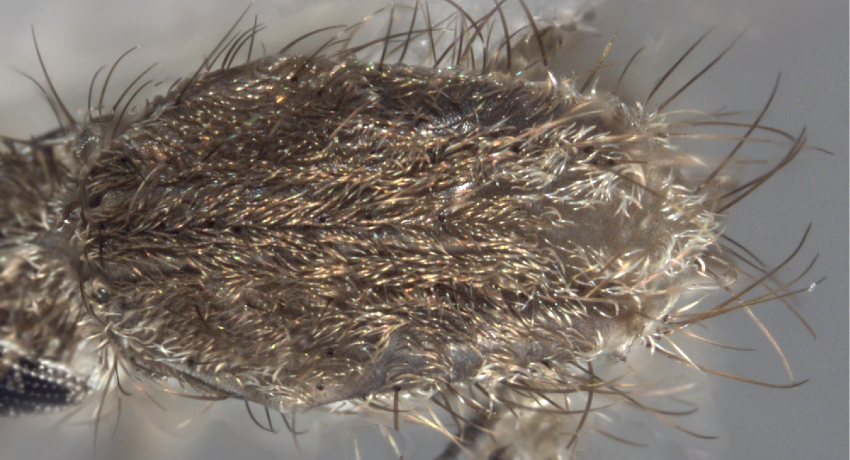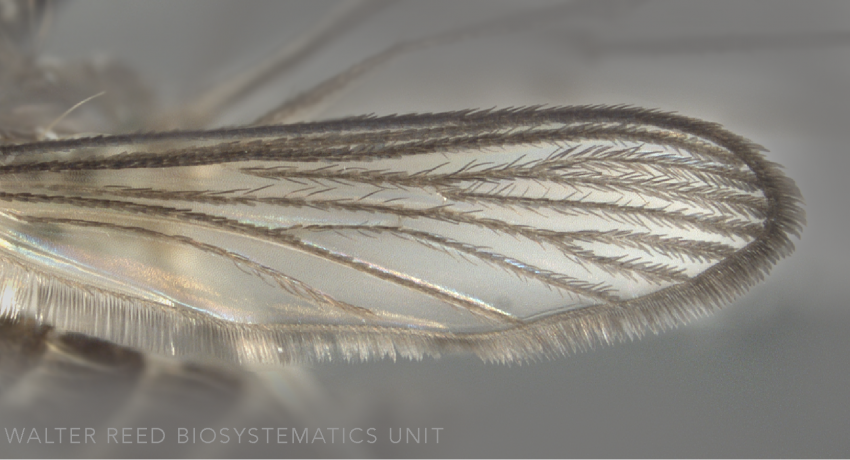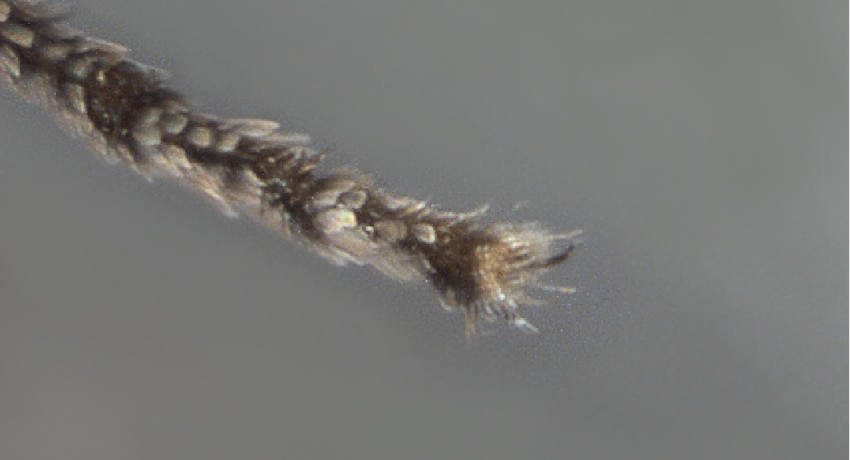AFROTROPICAL, AUSTRALIAN, NEOTROPICAL, ORIENTAL & PALEARCTIC REGIONS
Generic abbreviation: Lt.
Type species: Culex bigoti Bellardi
Etymology: Adolfo Lutz
The genus Lutzia comprises eight large, drab species, arranged in three subgenera: Insulalutzia (Lt. shinonagai (Tanaka, Mizusawa & Saugstad) from Japan), Lutzia (Lt. allostigma Howard, Dyar & Knab and Lt. bigoti (Bellardi) from the Neotropicas), and Metalutzia Lt. agraensis Singh & Prakash (India); Afrotropical Lt. tigripes (de Grandpre & de Charmoy), Oriental Lt. vorax Edwards, Lt. fuscana (Wiedemann) from the Oriental and Australasian regions; and Lt. halifaxii (Theobald), found from Australia to Pakistan. Lutzia species closely resemble those in the genus Culex, and some workers still consider Lutzia a subgenus of the latter.
DIAGNOSTIC CHARACTERS (Click photos to view; mouse over and click large photo to zoom in.)
ADULT (illustrated): Thorax: Antepronotum with narrow scales; 4–8 long mesepimeral setae; scutellum with narrow scales. Legs: Pulvillus large; Fe-I,II and Ti-I,II with anterior pale scale patches. Wing: Crossvein rm nearly at same level as base of vein M3+4.
LARVA (not illustrated): Head: Mouthparts modified for predation; mandible with strong teeth; maxillary brush with many strong pectinate hairs. Terminal segments: Siphon short, with continuous mid-posterior row of setae; pecten usually extends along entire length of siphon; saddle complete, extending dorsally much further than ventrally.
TAXONOMIC KEYS
Edwards 1941 (Afrotropics)
Rattanarithikul & Harrison et al. 2005 (Thailand)
Exemplar DNA sequences
Lt. allostigma COI:MF172338
Lt. tigripes COI: KU187026–30
Lt. halifaxii COI: KM609458
Lt. fuscana COI: KF407917–18, KF564755–56, HQ398896–97
BIONOMICS
Immatures
Larva of all Lutzia species are ferocious predators and obligate cannibals, acquiring all necessary energy stores for oogenesis as immatures. Immature habitats of species of the subgenus Metalutzia include temporary or permanent water bodies and natural or artificial containers, with the only apparent criteria being the presence of other mosquito larvae for food. Immatures of Lt. (Ilt.) shinonagai were collected in a tree hole.
Adults
Little is known on the bionomics of adult Lutzia, but at least Lt. (Lut.) allostigma and Lt. (Lut.) bigoti are autogenous. There are reports of female Lutzia attacking both domestic animals and, more rarely, people.
*Associated pathogens: This list reports bacteria, viruses, and parasites recovered from, or experimentally passed through this species, and does not imply field vector status.
IMPORTANT REFERENCES (full citations below)
Theobald 1903a: 155
Edwards 1932a: 190 (to subgenus of Culex)
Edwards 1941 (M, F, P; keys, taxonomy, as subgenus of Culex; Afrotropics)
Hopkins 1952 (L; taxonomy, as subgenus of Culex; Afrotropical Region)
Belkin 1962 (as subgenus of Culex; South Pacific)
Bram 1967b (as subgenus of Culex, Thailand)
Tanaka et al. 1979 (as subgenus of Culex, Japan)
Lee et al. 1989b (taxonomy, bionomics as subgenus of Culex; Australasian Region)
Miller et al. 1996 (molecular phylogeny)
Navarro & Liria 2000 (morphological phylogeny)
Liria & Navarro 2003b (taxonomy, class. L mouthparts)
Tanaka, 2003c: 159 (taxonomy, as genus; Japan)
Rattanarithikul & Harrison et al. 2005 (F, L; taxonomy, keys, bionomics; Thailand)
Deus 2009 (molecular phylogeny)
Vesgueiro et al. 2011 (molecular phylogeny)
Demari-Silva et al. 2011 (molecular phylogeny)
Harbach et al. 2012 (morphological phylogeny)
Kitching et al. 2015 (phylogeny; review of status)
VALID SUBGENERA
Insulalutzia Tanaka [Ilt.]
Lutzia Tanaka [Lut.]
Metalutzia Theobald [Mlt.]
CURRENT GENERIC & SUBGENERIC SYNONYMS
Metalutzia
syn. Jamesia Christophers 1906: 12 (not Jeckel 1861). Type species: Culex concolor Robineau-Desvoidy (Edwards 1932a: 190; as Culex fuscanus Wiedemann).
CITED REFERENCES
Belkin, J.N. (1962). The mosquitoes of the South Pacific (Diptera, Culicidae) (Vols. 1 &2). Berkeley, California: University of California Press.
Bram, R.A. (1967b). Contributions to the mosquito fauna of Southeast Asia. II. The genus Culex in Thailand (Diptera: Culicidae). Contributions of the American Entomological Institute, 2(1), 1–296.
Christophers, S.R. (1906). On the importance of larval characters in the classification of mosquitoes. Scientific Memoirs by Officers of the Medical and Sanitary Departments of the Government of India (Calcutta), New Series, 25, 1–18.
Demari-Silva, B., Vesgueiro, F.T., Sallum, M. A. M., & Marrelli, M.T. (2011). Taxonomic and phylogenetic relationships between species of the genus Culex (Diptera: Culicidae) from Brazil inferred from the cytochrome c oxidase I mitochondrial gene. Journal of Medical Entomology, 48(2), 272–279.
Deus, S. (2009). Phylogeny of selected species of subgenus Culex mosquitoes (Diptera: Culicidae) from the U.S., Puerto Rico, and Guatemala, based on nucleotide sequences from three genes. (PhD), Colorado State University, Fort Collins, CO.
Edwards, F.W. (1932a). Diptera family Culicidae. In P. Wytsman (Ed.), Genera insectorum (194th Fascicule) (pp. 1–258). Brussels, Belgium: Louis Desmet-Verteneuil.
Edwards, F.W. (1941). Mosquitoes of the Ethiopian Region. III. Culicine adults and pupae. Bulletin of the British Museum (Natural History) Entomology.
Harbach, R.E., Kitching, I.J., Culverwell, C.L., Dubois, J., & Linton, Y.-M. (2012). Phylogeny of mosquitoes of tribe Culicini (Diptera: Culicidae) based on morphological diversity. Zoologica Scripta, 41(5), 499–514.
Hopkins, G.H.E. (1952). Mosquitoes of the Ethiopian region. I. Larval bionomics of mosquitoes and taxonomy of culicine larvae (2nd ed.). London, UK: British Museum (Natural History).
Kitching, I.J., Culverwell, C.L., & Harbach, R.E. (2015). The phylogenetic conundrum of Lutzia (Diptera: Culicidae): A cautionary account of conflict and support. Insect Systematics and Evolution, 46(3), 269–290.
Lee, D.J., Hicks, M.M., Debenham, M.L., Griffiths, M., Bryan, J.H., & Marks, E.N. (1989a). The Culicidae of the Australasian region. Volume 8. Commonwealth Department of Health, School of Public Health and Tropical Medicine Monograph Series, 2.
Liria, J., & Navarro, J.-C. (2003b). Morphology of the larval mandible and maxilla in the subgenus Carrollia Lutz of Culex L. (Diptera: Culicidae). Zootaxa, 186(1), 1–8.
Miller, B. R., Crabtree, M. B., & Savage, H. M. (1996). Phylogeny of fourteen Culex mosquito species, including the Culex pipiens complex, inferred from the internal transcribed spacers of ribosomal DNA. Insect Molecular Biology, l5(2), 93–107.
Navarro, J.C., & Liria, J. (2000). Phylogenetic relationships among eighteen neotropical Culicini species. Journal of the American Mosquito Control Association, 16(2), 75–85.
Rattanarithikul, R., Harrison, B.A., Panthusiri, P., & Coleman, R.E. (2005). Illustrated keys to the mosquitoes of Thailand. I. Background; geographic distribution; lists of genera, subgenera, and species; and a key to the genera. Southeast Asian Journal of Tropical Medicine and Public Health, 36(1), 1–80.
Tanaka, K. (2003c). Studies on the pupal mosquitoes of Japan. (9) Genus Lutzia, with establishment of two new subgenera, Metalutzia and Insulalutzia (Diptera, Culicidae). Japanese Journal of Systematic Entomology, 9(2), 159–169.
Tanaka, K., Mizusawa, K., & Saugstad, E.S. (1979). A revision of the adult and larval mosquitoes of Japan (including the Ryukyu Archipelago and Ogasawara Islands) and Korea (Diptera: Culicidae). Contributions of the American Entomological Institute, 16, 1–987.
Theobald, F.V. (1903a). A monograph of the Culicidae of the World (Vol. 3). London: British Museum (Natural History). 359pp
Vesgueiro, F.T., Demari-Silva, B., dos Santos Malafronte, R., Sallum, M.A.M., & Marrelli, M.T. (2011). Intragenomic variation in the second internal transcribed spacer of the ribosomal DNA of species of the genera Culex and Lutzia (Diptera: Culicidae). Memórias do Instituto Oswaldo Cruz, 106(1), 1–8.
CITE THIS PAGE
Walter Reed Biosystematics Unit (Year). Lutzia genus page. Walter Reed Biosystematics Unit Website, http://wrbu.si.edu/vectorspecies/genera/lutzia, accessed on [date (e.g. 03 February 2020) when you last viewed the site].







